Restoring a classic car can be a great family project. Not only can the whole clan get in on the action, but the final product is something that they all get to enjoy. Deciding what that car will be can be a battle, but this 1968 Mustang Fastback shows some promise. It is a complete vehicle that runs and drives. Its rust problems are minimal, so the buyer could tackle most of these in a home workshop. Located in Manahawkin, New Jersey, you will find the Fastback listed for sale here on eBay. The owner has set the auction to open at $27,500, but there have been no bids. He has also set a BIN option at $29,500. While there have been no bids, there has been no shortage of interest. Ninety-seven people are currently watching the listing.
It appears that someone has done some work on this Mustang in the past. It rolled off the production line wearing Diamond Blue paint but has undergone a color change at some point. The owner believes that the rear quarter panels have been replaced, so the two things may be related. External rust is relatively minor. The spot that you can see near the leading edge of the quarter panel is one of the worst in the car. This could be addressed with a patch, as could the spot in the passenger door’s lower corner. The rest of the exterior looks good, with nothing visible in the lower fenders or rockers. The panels appear to be free of dings or dents, and the alignments all look consistent. Some of the chrome and trim will require restoration or replacement, but the glass appears to be in excellent order.
When we delve below the surface, we find the worst of the rust problems with this Mustang. However, there is nothing there that is likely to cause significant problems. The torque boxes look great, as do the inner rockers. There is plenty of surface corrosion, but most of the floors and the trunk pan appear sound. There are a few holes in the floor on the driver’s side, but I think that these could be addressed with patches. Both rear frame rails do have rust, but it is hard to see precisely how bad it is. They may require replacement, but since this is a common issue, it should prove to be a straightforward undertaking.
The original owner ordered the Fastback equipped with a C-Code 289ci V8, a 3-speed automatic transmission, and power steering. When in good health, this little V8 should be pumping out 195hp. This figure was a drop of 5hp compared to previous years, but it was still enough to send the Mustang through the ¼ mile in 16.7 seconds. That’s not mind-blowingly fast, but it still represented a respectable number in 1968. It isn’t clear whether the Fastback is a numbers-matching car, but it does run and drive. The owner has driven it around his local neighborhood, but it will need a thorough check and some mechanical work before it hits the highway. I have noticed that the power steering belt is missing, which suggests that there could be a problem with the system. With that addressed and some minor work on the brakes, it sounds like this little classic will be good to go. It is also worth noting that it is not difficult to extract more power from the C-Code motor. That means that if the buyer is not worried about originality, it is an option worth considering.
The Mustang’s interior has undoubtedly seen better days, and it will need to be completely refurbished. Once again, there are plenty of options for the buyer to consider. Trim kits are easy to find, and the costs of these depend on the sort of impact the buyer wants to make. Standard kits sell for less than $850, but one featuring Deluxe upholstery will cost around $1,250. From there, the sky’s the limit, but it is possible to spend $2,500 in the blink of an eye. However, the less expensive kits will include most of the parts required to have the interior presenting at its best.
Candidates for family projects generally need to be cars where most of the work can be undertaken by the individuals themselves. It is nice to send components out to a professional for restoration, but doing this means that some of the sense of satisfaction is lost if the family loses the hands-on experience. That is one of the things that makes this ’68 Mustang Fastback such an attractive candidate. Most of the work could be tackled in a home workshop, and the family would own a classic pony car when it rolls out of the workshop at the end of the process. That doesn’t necessarily have to be the fate of this car because there is no reason why it couldn’t be snapped up by an enthusiast and transformed into something special. The interest in this listing has been high, and I believe that someone will be taking this Mustang home pretty soon.
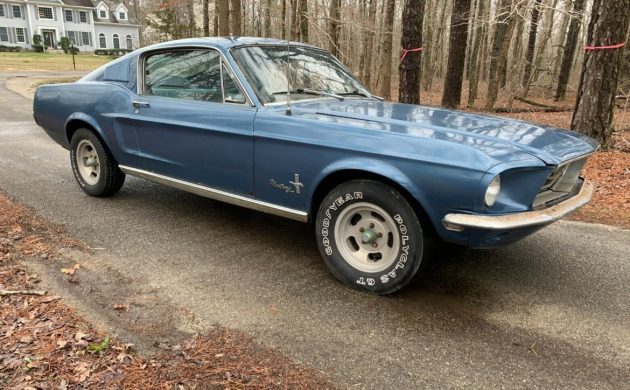
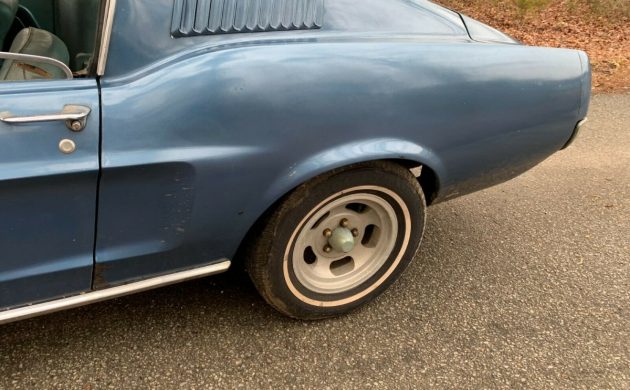
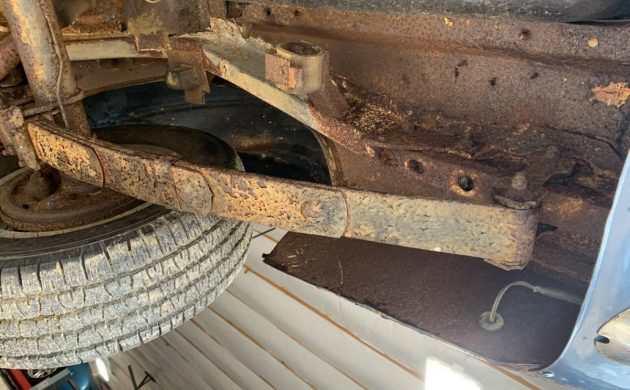
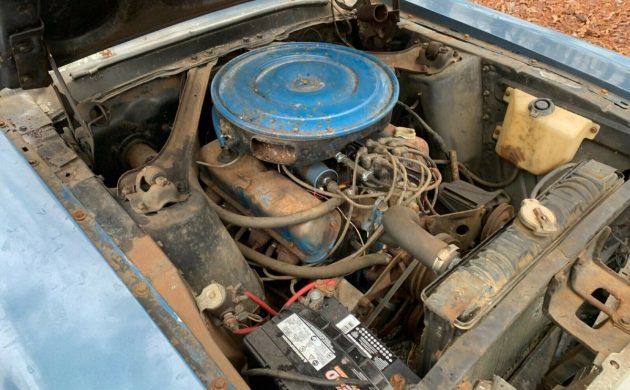
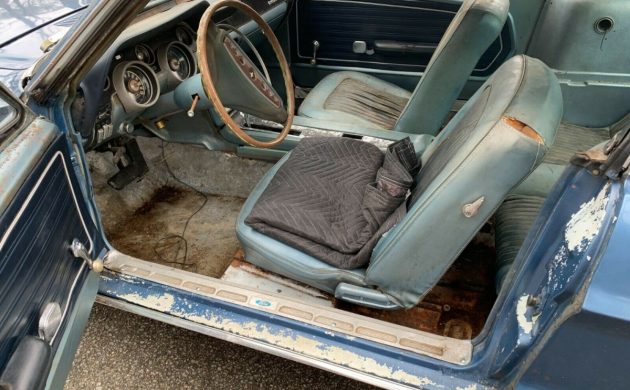
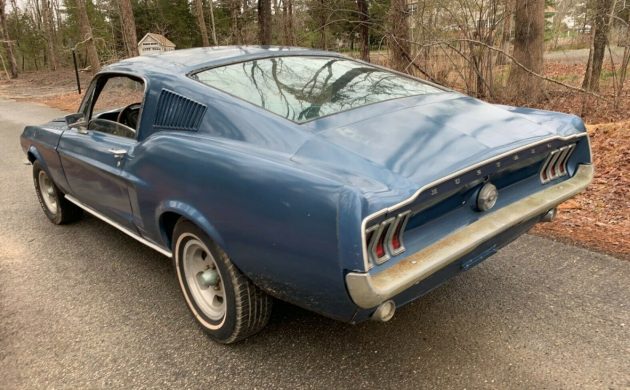


Very good write up Mr. Adam. This does look like something that is doable for a novice DIY’er… like myself. There are plenty of replacement parts on the market for mustangs but that bill can add up.
My only real concern is that underside. Once you gear up with your saftey glasses and wire brush there seems to be all kinds of little surprises awaiting you.
29.5K Hmmm I don’t know
Had a good friend of mine who had a ” Bullitt “clone of this car. It was his pride and joy, 390, 4 spd, just perfect. This was in Tucson, so it had never seen bad weather, garage kept, just immaculate. Unfortunately, he was killed in a motorcycle accident at the young age of 45. Every member of his family, after thinly veiled regards, asked about the Mustang. EVERY single one, his wife couldn’t believe it . She said she would rather go to the desert and set fire to it. RIP Dave, I hope the engine is howling, you are ripping through the gears, burning rubber, with that giant smile on your face.
People can be very insensitive at times. However, you could also look at it as complimenting Dave’s fine taste in automobiles.
After watching Bullit, this was the ultimate car, I wanted in High school. Unfortunately, living in Michigan, there weren’t too many available for a reasonable price in good condition. Ooh if this one was for sale back then at 10% of the asking price in 1982, I would of been a king of the world (IMO).
I like the ’67-68 fastbacks a little better than the earlier ones. Just a little bit more bold or something like that. And the fastbacks were always more money than the coupe models even back in the early eighties. The 289 is adequate for simple driving pleasures, plenty can be done to a 289 that will make it scream, however. Stock,,,…not really impressive. That was my take on a ’66 coupe 289-2 I had in high school.
Like the wheels on the one here as it gives it that cruiser vibe, not bad..
The rear quarters have has something done to them – both rear marker lights are MIA .
I am not positive on this but I believe that the early 68’s did not have the side marker lights. First production runs had nothing, second run had reflectors in the rear qtrs and the later production had the actual lights. Once again, I may be wrong but I seem to remember hearing that. I did have a 68 fastback and mine did have side marker lights.
All 68 Mustangs had front side marker lights and rear reflectors. There are 2 different styles of rear reflectors though. There were no rear side marker lights until the 1969 model year.
Once you don’t care about matching numbers, this fastback is way more expensive than other options if you want to return it to a really nice looking, reliable car. As an alternative, buy a pristine coupe ( far less expensive), cut off the top and turn it into a fastback ( parts readily available). Put in a new Ford 433 ci (7.3L) crate engine (the footprint is smaller and it is lighter than a 351 Windsor!). You won’t be in it for much more than this one when you add up this one’s restoration costs. And you can make it handle right as well. From the exterior you can make it look bone stock ( though I gotta have Torq Thrust wheels).
If this was an original 390 with 4 speed toploader I wouldn’t make the same argument. But this one ain’t….
Make a fastback ? Why ?
Make another perfect Bullitt clone. It’s the right year, and you’ll easily find a buyer.
Like the article. I believe this is not a 68, it’s a 67. There is not rear quarter panel reflectors which indicates the difference between a 67 & 68. I had a 68 1/2 GT Fastback Deluxe back on HS/College and loved it. Great article.
Early 68’s did not have the reflectors in the quarter panels. A 67 had fake vents in front of the rear tires where as a 68 just had a recessed area, like this car. Plus a 68 had cornering lamps in the front fenders, 67 didn’t. 68 had Mustang spelled in cursive on the front fenders, 67 was block lettering. 67 had FORD across the end of the hood, 68 didn’t. 67 had a cross bar in the front grille, similar to a 66 but 68 just had a flat grille with a Mustang emblem in the center. This is definitely a 68.
This is a 68. Did you look at the photos showing the door data plate and the buck tag? They both clearly show the VIN which starts with an 8. And that makes this car a 1968 model.
Also, 67’s had a grid work in the c notch that the ’68 did not.
Maybe it is just me, but I couldn’t just tart this one up knowing that everything underneath is rusty. I couldn’t paint the body it knowing all of that was on the underside – couldn’t sleep (like, the rust underneath).
Priced right (not saying it is or isn’t, that’s up to the buyer) if it were me I’d disassemble it, dip it, and build my own personal 1968 fastback the way I want it!
cheers,
BT
Doesn’t the VIN shows it a 68?
NO NO NO… If whoever can afford to buy this at 30k, whoever can use their smarts and scrap up another 20 to 30k and buy one that will put this to shame. Think, Think, Think on paper how much this will cost to build and you will realize buying this at this price is a loss. Then there are all the headaches and time to do so. I can go on forever so do your homework and if anything buy a rust-free one.
I agree that a novice ( like me) could get into big trouble with this car these 67 and 68 fastbacks are getting huge money as resto mods. A pro can do really well with this… just my opinion